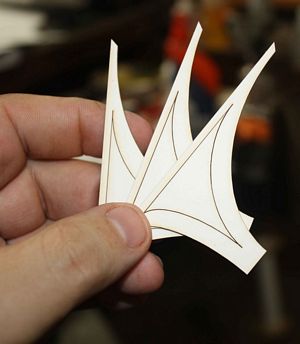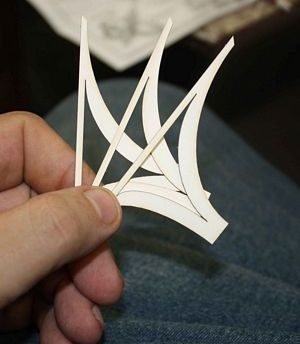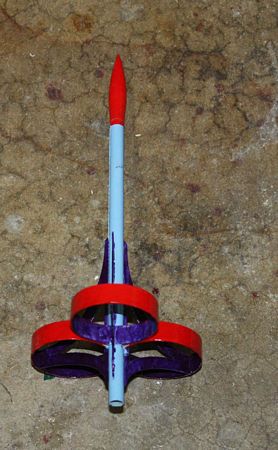| Construction Rating: | starstarstarstarstar_border |
| Flight Rating: | starstarstarstarstar_border |
| Overall Rating: | starstarstarstarstar_border |
| Diameter: | 0.28 inches |
| Length: | 8.63 inches |
| Manufacturer: | FlisKits  |
| Skill Level: | 2 |
| Style: | Futuristic/Exotic, Ring/Tube/Cone Fin, MicroMaxx, Downscale |
Brief:
The Dead Ringer is a sort of downscale of the FlisKits Borealis, one of the coolest in the FlisKits Fleet in my opinion. This will be my first attempt at a MMX build. I have plenty of kits but the idea of working with the extremely small sizes have intimidated me.
Construction:
I started off with a mistake because I glanced at the instructions instead of reading them. I marked off 1/4" on the 3/16" x 2" launch lug and cut it off. Then I got around to reading and realized that it was not supposed to be cut, just marked. Luckily, I had some lugs of the same size lying around. I got one of those and marked it properly. The lug was to serve as both an engine block and a tube coupler. It was inserted up to the mark in the short piece of BT2.5 tubing and glued in place with white glue.
The three ring fins came already cut. The next step was to glue them tangentially to each other. I did so with white glue.
When the coupler/BT had a chance to set up a bit, it was inserted into the longer BT2.5 and glued into place. That was a mistake that would soon become apparent.
Allow me to digress a bit here to emphasize something important with all rocket kits: read the instructions. Making sure you understand what is meant as opposed to what you assume is meant is a good idea too.
We now return to our build.
 I slipped the ring fins around the body tube and glued them in place at the juncture between the two tubes. The fit was a bit tight but nothing exceptionally so. I soon learned the reason for this.
I slipped the ring fins around the body tube and glued them in place at the juncture between the two tubes. The fit was a bit tight but nothing exceptionally so. I soon learned the reason for this.
The next step involved the mounting of the Kevlar shock cord. It was supposed to have been threaded through the longer BT, knotted, and then glued between the coupler/ring fins/body tube. I should not have yet glued the two body tubes together. The fit was tight because only the coupler should have gone through the hole between the ring fins. The two body tubes were to butt up against the rings. However, the glue was already dry.
I decided to try and bull my way through the build since I wanted to have a MMX rocket besides the plastic Quest one in time for a Vacation Bible School class in a few days.
I examined the fins. They were nice and had only to be removed from the stock and have the central mass punched out.


The body tube was marked with the end guide and then the fins were glued into place inside the rings. They fit fine against the opposite sides of the rings and at this point I learned another reason for the use of the coupler as opposed to a single BT. Using the coupler as intended meant that the fins would have laid flat for their entire length instead of just against the inner surface of the rings. I was going to have to fill the gaps with heavy white glue fillets.
The Dead Ringer has a nicely turned balsa nose cone. Most nose cones would be secured to the recovery system with a screw eye but that is not the case here. You probably have to pay extra to get screws machined that small. Instead, there is a small nail that is driven into the end. Accepting some advice from TRF, I further secured the nail with some glue.
I still had to figure out a way to secure the recovery system. The only way I could think of that did not involve scrapping everything was to borrow a page from some competition rockets and run the Kevlar along the outside. After all, I wasn't sure the Kevlar would fit in that little bitty BT anyway. I tied a knot in one end of the Kevlar and laid it along the root of one of the fins. The Kevlar was then filleted into place with white glue.
The nose cone was "sealed" with a drizzling of thin CA and then test fit into the body tube. It was just a little bit tight but a couple passes with an emery board made it fit. Three passes would probably have obliterated the entire cone. The Kevlar was then tied to the nail and sealed with a drop of white glue.
The kit comes with 2 little bitty launch lugs meant to be mounted on the body tube. My blunder with the tubing meant that mounting them flush with the BT would have caused clearance problems with the rod getting by the rings. I decided that since the rocket weighs so little, I could get by with a single lug and mounted it along the root edge of a fin inside of one of the tail rings.
All that was left was to tape the streamer into place on the Kevlar and wrestle it all into the body tube. That took longer than the assembly of the rocket. With that it was ready for finishing.
Finishing:
Finishing for the Dead Ringer began with me wondering what I was going to do. I finally decided I could not go too wrong by giving everything an undercoating of white. With that in mind, I sprayed it with a coat of Krylon white.
After looking around a bit, I decided to go with a light blue and sprayed the entire body except for the nose cone. It received 2 coats. When the blue had dried, I pulled out a bottle of red and hand painted the outsides of the rings. The red was given about an hour to dry and then a second coat was brushed on to cover up the places where it was a bit thin the first time. Additionally, I put a ring of cellophane tape around the BT about 1/4" down from the nose cone and painted everything forward of the tape red as well.
I liked the blue and red combination I had gotten thus far but I wanted to do something more. I decided to apply a purple I had sitting around to the interior of the rings and to the fins. My experience with this paint before was that it would need several coats.
A day later, I brushed on another coat of the purple and, while it improved the splotchiness, it was readily apparent that a third and perhaps even a fourth coat would be needed. The third coat improved things much more but I still figured at least one more would be needed. Two days later, the fourth coat was added. It did deepen the color but I figured that I would make do with just the four coats since the bottle chose that point to inconsiderately run out of paint.
That being the case, my first purpose built MMX rocket was ready to fly.
Construction Rating: 4 out of 5

Flight:
Prior to this, my only MMX launches had been of the Quest plastic bricks so I had little idea of what to expect. I did plan on using up an entire box of 6 motors trying it out but fate had other ideas in store for me.
The MMX motor was loaded and I went to open one of the packages of pyrogen free igniters I had ordered from FlisKits. I grabbed the wrong bag and the igniters all had pyrogen. I went ahead and used a sharpened twig to plug the igniter hole, set it up on the pad and let everyone know. MMX is an oddity at my club and the only ones I know of to have been previously flown are the previously mentioned plastic bricks.
When the launch button was pushed, it streaked off the pad giving a much better performance than any of the plastic rockets. The problem was following the small target with my increasing elderly eyes.
Ejection seemed to take place before apogee but I could not swear to it. What did happen was that the Kevlar thread parted and the nosecone and streamer were lost, putting and end to the day's flights of this rocket.
Later on in the day, another flier found the nosecone while walking back from searching for his rocket. It will be fixed and flown again.
Recovery:
I can't complain about the recovery of this rocket since I messed up and did not build it according to plan.
Flight Rating: 4 out of 5
Summary:
This was a nice little introduction to building and flying an MMX rocket. The kit was easy and has much to recommend it, especially if you don't have much room in which to fly.
Overall Rating: 4 out of 5
Other Reviews
- FlisKits Dead Ringer By Kathy Kippen (July 11, 2009)
A MicroMaxx kit with unique large rings for fins. The parts came very well packaged and include: ¼" x 2" coupler BT-2.5 x 1" tube BT-2.5 x 5" tube Launch lug Streamer 30" Kevlar thread shock cord Laser cut fins Three BT-60 x 3/8" rings Balsa nosecone Tiny nail Instruction sheet The instructions are easy to follow with easy to follow ...
- FlisKits Dead Ringer By Chan Stevens (April 26, 2009)
This is a sweet little micro-sized design based on the larger Borealis} (though it's not a pure downscale, as this is a much simpler design). It's another great addition to the {{http://www.jonrocket.com/index.php?main_page=index&cPath=1_39_61 line of true ...
 |
 |
Flights
Sponsored Ads
 |
 |












